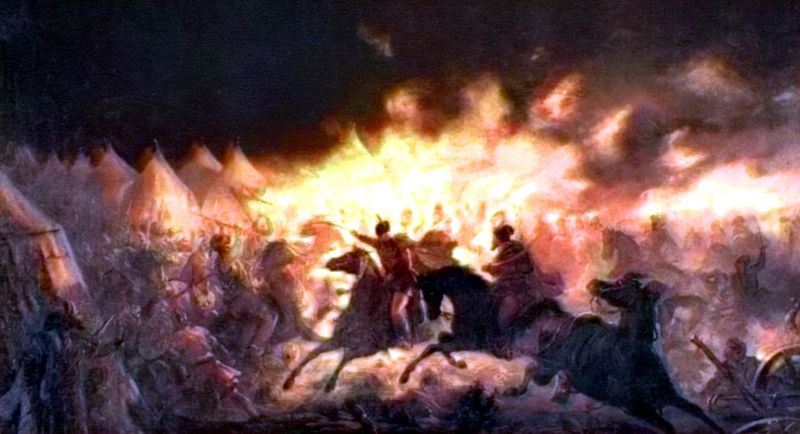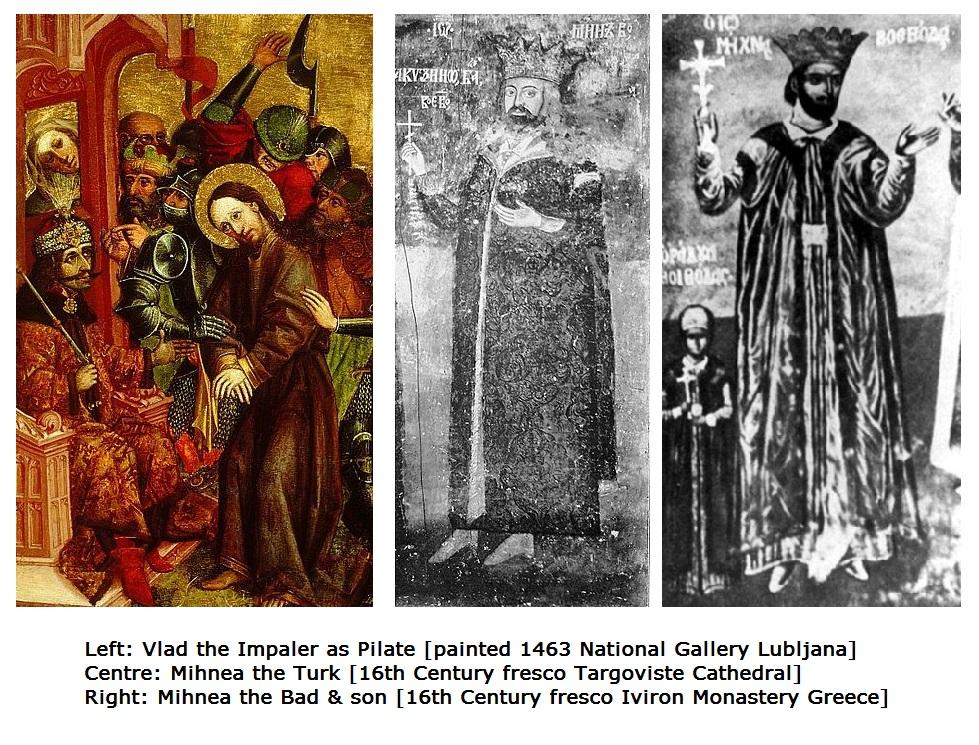
The Battle of the Torches (depicting Vlad's night attack on the Turks at Targoviste) by Romanian artist Theodor Aman 1831-1891
DRACULA’S CHILDREN – WHAT HAPPENED TO THE DESCENDANTS OF VLAD THE IMPALER?
The infamous Vlad the Impaler died fighting his numerous enemies sometime around Christmas 1476. According to Leonardo Botta, Milan’s ambassador to the Hungarian court, Vlad's corpse was hacked to pieces and his head sent to Mehmed II. However, though the dragon had been decapitated, Vlad’s branch of the House of Drăculeşti did not die.
Vlad the Impaler married at least twice and whilst his brief second marriage was almost certainly childless, his first wife bore him at least three sons. Vlad’s middle son died sometime around 1486, and his youngest heir disappears from history after 1495, but after decades of living in hiding, Vlad’s eldest son, Mihnea, managed to reclaim the throne of his forefathers.
Mihnea cel Rău (the Bad) was born c.1460 and his life must have been a never-ending nightmare because he was at the centre of a century-long war for Wallachia’s throne. Just as 15th Century England was torn apart by rival Lancastrian and Yorkist factions, so Wallachia was plunged into chaos by a dynastic conflict that was much longer and even more bloody than the Wars of the Roses.
The years of fratricidal struggle began in 1422 when Wallachia’s ruling House of Basarab fractured into the Drăculeşti and Dănești clans. Vlad the Impaler was a Drăculeşti (hence his cognomen Dracula) and after his death his sons were hounded by competing rivals for Wallachia’s crown. It wasn’t until 1508 that Mihnea managed to succeed his father as Voivode (prince) and to do so he had to depose his own cousin Radu cel Mare (the Great).
In an attempt to secure the succession for his own heirs, Mihnea made his son, Mircea, co-ruler. Mihnea also followed his father’s example by using unspeakable cruelty to cow his subjects and a contemporary chronicle (The Life & Deeds of St Niphon Patriarch of Constantinople by the Greek monk Gavriil Protul) describes his reign of terror:
"As soon as Mihnea began to rule he at once abandoned his sheep's clothing and plugged up his ears like an asp [to avoid hearing pleas for mercy]. He took all the great boyars captive, worked them hard, cruelly confiscated their property, and even slept with their wives in their presence. He cut off the noses and lips of some, hanged others and still others he drowned…"
According to medieval bestiaries the asp pressed one ear to the ground and plugged the other with its own tail to avoid hearing the music of snake charmers but emulating such bizarre behaviour was of no help to Mihnea. A rebellion by a third faction, the Craiovești, forced him and his son Mircea into exile. Settling in the Transylvanian city of Sibiu, which at this time was ruled by Hungary, Mihnea began plotting his return to power but in 1510, whilst attending mass at the city’s catholic cathedral, he was ambushed by an assassin in the pay of the Craiovești and stabbed to death.
Somehow Mircea escaped the assassin’s knife and he spent the next few years hunting down those responsible his father’s death. According to legend, Mircea strangled those he caught with his bare hands but whilst he is recorded as having married in 1519, nothing more is heard of him after this date. Nevertheless Alexander, the eldest of Mircea’s two son became Prince of Wallachia in 1568. Alexander also ruled with an iron fist before being poisoned by rivals in 1574.
Mircea’s other son, Peter the Lame, was elected Prince of Moldavia in 1574 but, unusually for a descendant of Vlad the Impaler, he was a weak ruler who preferred pursuing women to persecuting his hereditary enemies. That said, his reign was not without controversy. In a scandal reminiscent of Edward VIII’s abdication of the British throne, Peter married a gypsy slave named Irina, whom he freed, before giving up the Moldavian crown and retiring to Bolzano in Italy. Whilst enjoying his comfortable retirement, Peter took Irina’s maid as his mistress and contracted the syphilis which killed him in 1594.
Back in Wallachia, Alexander’s son, Mihnea II, became Voivode in 1577. Known as Mihnea Turcitul (the one who turned Turk) this great-grandson of Vlad the Impaler converted to Islam in an attempt to secure Ottoman support for his rule. This policy was only partially successful because, although Mihnea who-turned-Turk was succeeded by his illegitimate son (called Radu-Mihnea), he was deposed and demoted to the governorship of a town in Bulgaria.
Radu-Mihnea ruled both Wallachia and Moldavia, albeit with repeated interruptions, from 1601 until his death in 1626. His wife Arghira bore him two daughters and three sons including Alexandru Coconul (child-prince)who died in 1632 and Mihnea III who briefly ruled Wallachia from 1658 to 1659. No child of Mihnea III has yet been traced so with his death the direct male line of Vlad the Impaler becomes extinct.
However, Vlad’s descendants in the female line do exist and his other relatives include our own Prince of Wales. Thanks to his great-grandmother Mary of Teck, Prince Charles can trace his lineage back to Vlad the Monk, half-brother of Vlad the Impaler, and one of the few Drăculeşti to die a natural death!
Vlad the Impaler’s grandson Mircea is the inspiration for Lord Dracul, one of the chief characters in The Devil's Lance...
